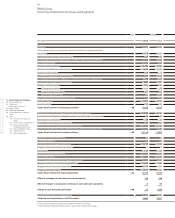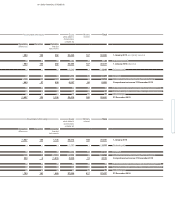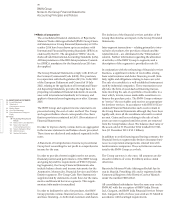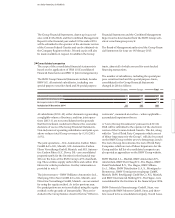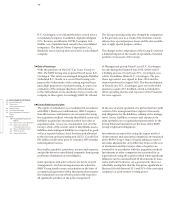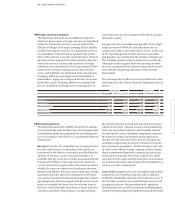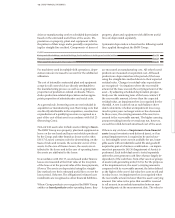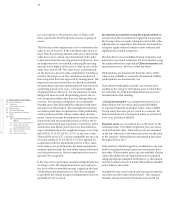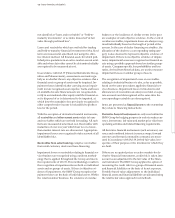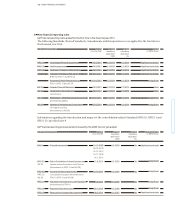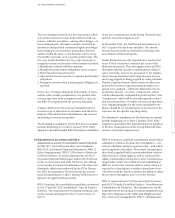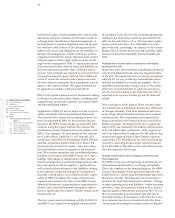BMW 2014 Annual Report Download - page 103
Download and view the complete annual report
Please find page 103 of the 2014 BMW annual report below. You can navigate through the pages in the report by either clicking on the pages listed below, or by using the keyword search tool below to find specific information within the annual report.
103 GROUP FINANCIAL STATEMENTS
For machinery used in multiple-shift operations, depre-
ciation rates are increased to account for the additional
utilisation.
The cost of internally constructed plant and equipment
comprises all costs which are directly attributable to
the
manufacturing process as well as an appropriate
proportion of production-related overheads. This in-
cludes production-related depreciation and an appro-
priate proportion of administrative and social costs.
As a general rule, borrowing costs are not included in
acquisition or manufacturing cost. Borrowing costs that
are directly attributable to the acquisition, construction
or production of a qualifying asset are recognised as a
part of the cost of that asset in accordance with IAS 23
(Borrowing Costs).
Non-current assets also include assets relating to leases.
The BMW Group uses property, plant and equipment as
lessee on the one hand and leases out vehicles produced
by the Group and other brands as lessor on the other.
IAS 17 (Leases) contains rules for determining, on the
basis of risks and rewards, the economic owner of the
assets. In the case of finance leases, the assets are at-
tributed to the lessee and in the case of operating leases
the assets are attributed to the lessor.
In accordance with IAS 17, assets leased under finance
leases are measured at their fair value at the inception
of the lease or at the present value of the lease payments,
if lower. The assets are depreciated using the straight-
line method over their estimated useful lives or over the
lease period, if shorter. The obligations for future lease
instalments are recognised as other financial liabilities.
Where Group products are recognised by BMW Group
entities as leased products under operating leases, they
are measured at manufacturing cost. All other leased
products are measured at acquisition cost. All leased
products are depreciated over the period of the lease
using the straight-line method down to their expected
residual value. Changes in residual value expectations
are recognised – in situations where the recoverable
amount of the lease exceeds the carrying amount of the
asset – by adjusting scheduled depreciation prospec-
tively over the remaining term of the lease contract. If
the recoverable amount is lower than the expected
residual value, an impairment loss is recognised for the
shortfall. A test is carried out at each balance sheet
date
to determine whether an impairment loss recog-
nised in prior years no longer exists or has decreased.
In these cases, the carrying amount of the asset is in-
creased to the recoverable amount. The higher carrying
amount resulting from the reversal may not, however,
exceed the rolled-forward amortised cost of the asset.
If there is any evidence of impairment of non-financial
assets (except inventories and deferred taxes), or if an
annual impairment test is required to be carried out –
i. e. for intangible assets not yet available for use, intan
gible assets with an indefinite useful life and goodwill
acquired as part of a business combination – an impair-
ment test pursuant to IAS 36 (Impairment of Assets) is
performed. Each individual asset is tested separately
unless the asset generates cash flows that are largely in-
dependent of the cash flows from other assets or groups
of assets (cashgenerating units / CGUs). For the purposes
of the impairment test, the asset’s carrying amount is
compared with its recoverable amount, the latter defined
as the higher of the asset’s fair value less costs to sell and
its value in use. An impairment loss is recognised when
the recoverable amount is lower than the asset’s carrying
amount. Fair value is the price that would be received
to sell an asset in an orderly transaction between
mar-
ket participants at the measurement date. The value in
in years
Factory and office buildings, residential buildings, fixed installations in buildings and outside facilities 8 to 50
Plant and machinery 3 to 21
Other equipment, factory and office equipment 2 to 25
sition or manufacturing cost less scheduled depreciation
based on the estimated useful lives of the assets. De-
preciation on property, plant and equipment reflects
the pattern of their usage and is generally computed us-
ing
the straight-line method. Components of items of
property, plant and equipment with different useful
lives are depreciated separately.
Systematic depreciation is based on the following useful
lives, applied throughout the BMW Group:



